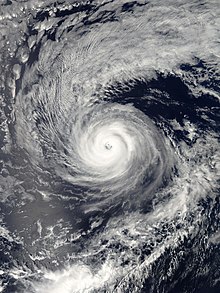 Hurricane Olivia near peak intensity with annular characteristics on September 6 | |
| Meteorological history | |
|---|---|
| Formed | September 1, 2018 |
| Remnant low | September 14, 2018 |
| Dissipated | September 14, 2018 |
| Category 4 major hurricane | |
| 1-minute sustained (SSHWS/NWS) | |
| Highest winds | 130 mph (215 km/h) |
| Lowest pressure | 950 mbar (hPa); 28.05 inHg |
| Overall effects | |
| Fatalities | None |
| Damage | $25 million (2018 USD) |
| Areas affected | Hawaii |
| IBTrACS / [1] | |
Part of the 2018 Pacific hurricane season | |
Hurricane Olivia was a tropical cyclone that impacted Hawaii as a weakening tropical storm in mid-September 2018, causing severe flooding and wind damage. Olivia was the first tropical cyclone to make landfall on Maui and Lanai in recorded history. It was the fifteenth named storm, ninth hurricane, and sixth major hurricane of the 2018 Pacific hurricane season.[2][nb 1]
A tropical depression formed southwest of Mexico on September 1, and slowly organized while hindered by northeasterly wind shear, strengthening into Tropical Storm Olivia a day later. Olivia began a period of rapid intensification on September 3, reaching its initial peak as a high-end Category 3 hurricane on September 5. Soon after, the cyclone began to weaken, before unexpectedly re-intensifying on September 6. Olivia peaked as a Category 4 hurricane on September 7, with winds of 130 mph (215 km/h) and a minimum pressure of 951 mbar (28.08 inHg). Six hours later, Olivia began another weakening trend that resulted in the hurricane being downgraded to Category 1 status on September 8, east of the 140th meridian west. Olivia entered the Central Pacific Basin on September 9 while continuing to decay. For much of its existence, Olivia had tracked westward to northwestward under the influence of a subtropical ridge. The cyclone weakened to a tropical storm on September 12, while turning towards the west-southwest as a result of trade winds. Olivia made brief landfalls on Maui and Lanai, with winds of 45 mph (75 km/h), later in the day. Olivia fluctuated in intensity as it tracked away from the Hawaiian Islands, before transitioning to a post-tropical cyclone on September 14. It opened up into a trough of low-pressure several hours later.
Olivia's approach towards the Hawaiian Islands prompted the issuance of tropical storm watches and warnings for Hawaii County, Maui County, the island of Oahu, and Kauai County. Hawaii Governor David Ige declared Hawaii, Maui, Kalawao, Kauai, and Honolulu counties disaster areas prior to Olivia's landfall in order to activate emergency disaster funds and management. Tropical-storm-force winds mainly affected Maui County and Oahu. Torrential rainfall occurred on both Maui and Oahu, peaking at 12.93 in (328 mm) in West Wailuaiki, Maui. Olivia felled trees, and caused thousands of power outages and severe flooding on Maui. Floodwaters deposited debris on roads and caused severe damage to portions of highways, most notably Lower Honoapiilani Road where cliffs were eroded along its shoulder; repairs to that road are still ongoing as of January 2021. In Honokohau Valley, the Honokohau stream rose over 15 ft (4.6 m), submerging a bridge and inundating over a dozen homes. Multiple homes and vehicles were swept away by floodwaters. Olivia left the valley without potable water for more than a week. Ditch systems in the valley that supply water to residents were damaged during the storm; repairs cost $300,000–$400,000 (2018 USD) and finished during May 2020. Several hundred power outages occurred on Molokai, and around 1,100 lost power in Honolulu. A pipe overflowed from excessive rainfall on Oahu, sending raw sewage into Kapalama Stream and Honolulu Harbor. United States President Donald Trump issued a disaster declaration for Hawaii to aid with emergency response efforts. Olivia caused a total of $25 million in damage throughout Hawaii.
- ^ Cite error: The named reference
TCRwas invoked but never defined (see the help page). - ^ National Hurricane Center; Hurricane Research Division; Central Pacific Hurricane Center (April 26, 2024). "The Northeast and North Central Pacific hurricane database 1949–2023". United States National Oceanic and Atmospheric Administration's National Weather Service. Archived from the original on May 29, 2024. A guide on how to read the database is available here.
 This article incorporates text from this source, which is in the public domain.
This article incorporates text from this source, which is in the public domain.
- ^ "Saffir-Simpson Hurricane Wind Scale". National Hurricane Center. Archived from the original on 20 June 2020. Retrieved 22 June 2020.
Cite error: There are <ref group=nb> tags on this page, but the references will not show without a {{reflist|group=nb}} template (see the help page).